Eight Red Birds to Know in North America
There's nothing like the flash of a red bird at the feeder to draw your eye to the window. In winter snow or summer greenery, red birds stand out, and the relatively small number of all-red or mostly red bird species in the United States and Canada makes them all the more bewitching to birders.
As you can probably guess, red feathers aren't about camouflage — they're about communication. Brilliant colors convey the message that a male bird is fit and healthy enough to grow flashy plumage and to deal with the attention from predators that might result. This, in turn, attracts mates and warns away potential competitors.
Red, yellow, and orange pigments in bird feathers come from molecules called carotenoids. Birds can't make their own carotenoids, but they ingest them in their food, from sources such as red berries. When a berry is digested, the carotenoids it contains pass through the bird's liver and bloodstream before eventually being deposited in the outer layers of growing feathers. Carotenoids are naturally yellow, but in 2016, scientists identified the special enzymes that let red birds turn yellow carotenoids into red ones.
To help you better know these red species, we've assembled a list of eight iconic birds of the U.S. and Canada in no particular order. We're defining a “red bird” as a bird that's mostly red (though many birds on our list also have non-red areas). We're not counting rufous, cinnamon, or pink birds, but we are including species where only the males are red. There is no perfect list of red birds, and if we've left out your favorite red bird, feel free to let us know!
8) Northern Cardinal
Northern Cardinals are probably the first species North American birders imagine when they picture a red bird. Once most common in the southern U.S., cardinals have expanded their range northward over the last century as habitat has changed. There are also introduced populations of cardinals in California, Hawaii, and Bermuda.
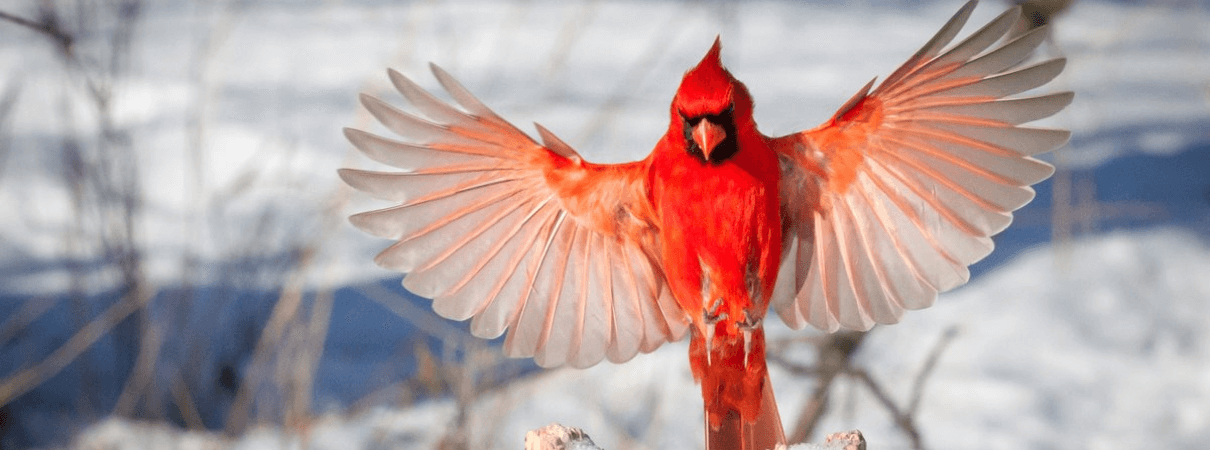
Northern Cardinal photo by Phil Lowe/Shutterstock
Very rarely, birdwatchers have documented male cardinals that are yellow instead of red, and scientists believe these unusual individuals may have a genetic mutation that makes them incapable of converting the yellow carotenoids they ingest into red pigment.
7) Scarlet Tanager
The brilliant contrast of a scarlet body and jet-black wings may seem like it would make Scarlet Tanagers easy to spot, but these Neotropical migrants prefer to lurk in leafy treetops where they're hard to see.
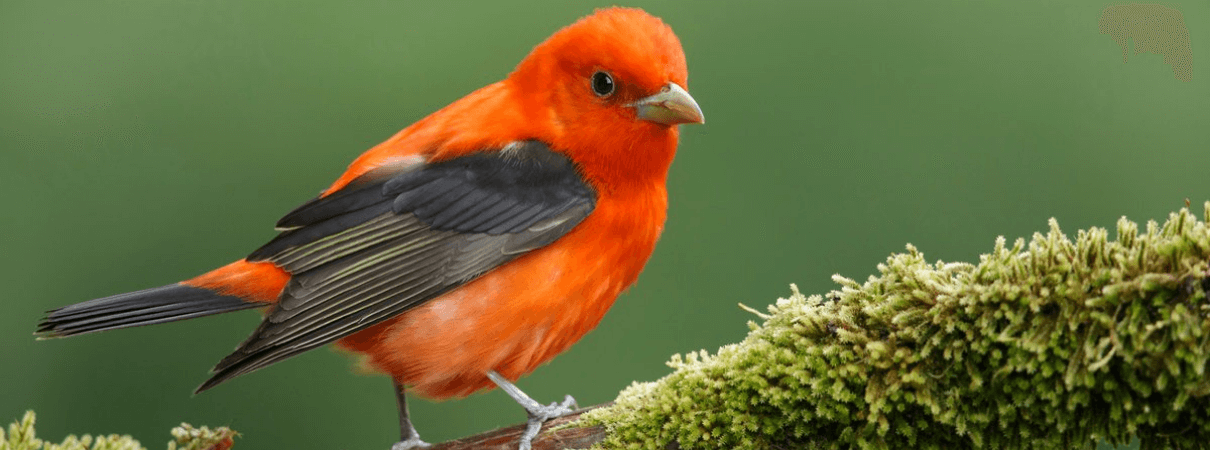
Scarlet Tanager photo by Agami Photo Agency/Shutterstock
Despite their name, Scarlet Tanagers and the two other tanager species that follow are no longer considered part of the tanager family, but are instead categorized with their fellow red bird — the Northern Cardinal — in the cardinal family. Because they favor interior forest habitat, Scarlet Tanagers may be especially vulnerable to habitat fragmentation.
6) Summer Tanager
The reddest bird on our red bird list! Male Summer Tanagers are bright cherry-red all over, with no dark markings at all. This tanager species stands out from its cousins by being a bee and wasp specialist, catching stinging insects in mid-air, although like other tanagers it also eats a variety of other insects, as well as fruit.

Summer Tanager photo by Frode Jacobsen/Shutterstock
Summer Tanager populations are mostly stable, but some are declining in parts of the species' breeding range due to habitat loss.
5) Hepatic Tanager
Hepatic Tanagers get their name from the brownish tinge to the males' red plumage, which reminded early ornithologists of the color of liver (“hepatic” is a Latin word that means “relating to the liver”). This species has the most limited North American range of the three tanagers on this list, breeding primarily in highlands of the Southwest, in open woodlands of conifers and oaks.
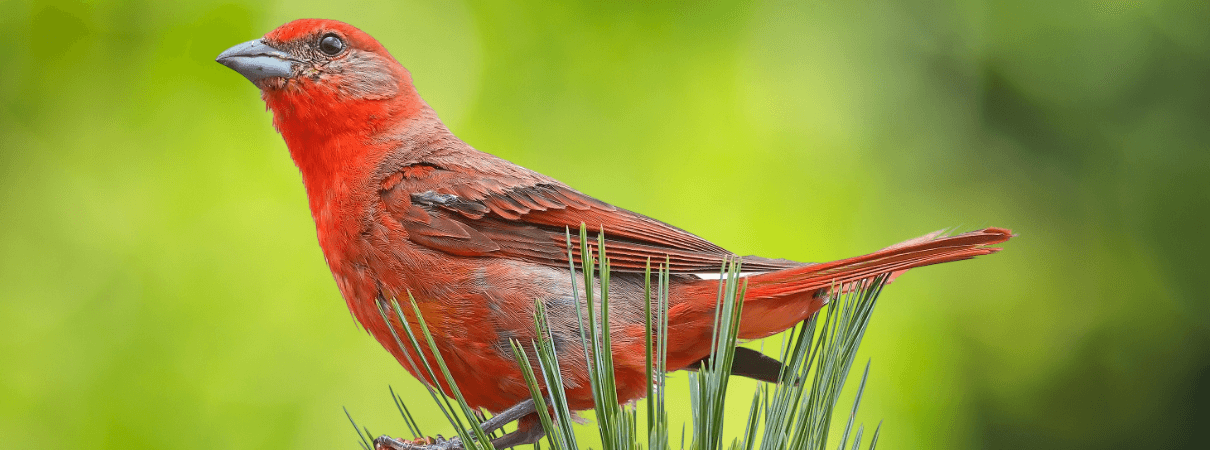
Hepatic Tanager photo by Greg Homel
This is the only North American tanager that doesn't completely depart the United States each winter — a few overwinter in southern Arizona each year.
4) Vermilion Flycatcher
Some North American flycatchers are plain-looking and hard to tell apart, but not the Vermilion Flycatcher. The dashing males have a dark-brown mask set off by a brilliant red-orange crest and underparts.
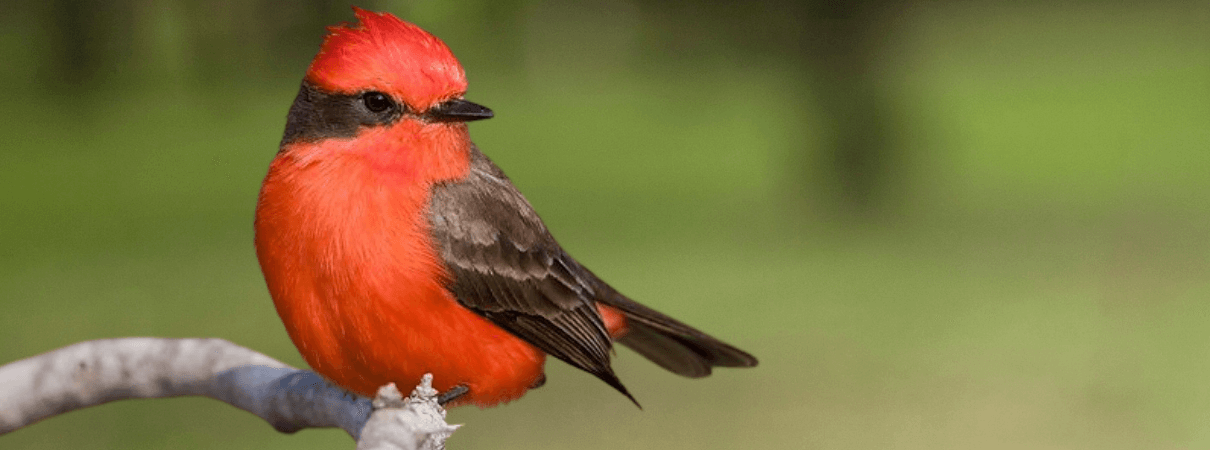
Vermilion Flycatcher photo by Glenn Bartley
These red birds live mainly in riparian areas of the Southwest and, like other flycatchers, sit on exposed perches watching for insect prey, which they capture in flight. Courting males perform impressive “flight displays” for females, calling and circling above the vegetation in a rising-and-falling pattern.
3) Pine Grosbeak
From boreal forest to suburbs, Pine Grosbeaks live throughout the northern regions of Eurasia as well as North America. Across their large range, this species is divided into nine subspecies based on differences in bill size, wing and tail length, and overall body size. These oversized finches form gregarious flocks and primarily eat seeds, buds, and fruit.

Pine Grosbeak photo by Mircea Costina/Shutterstock
Although the details of their plumage color have not been well-studied, captive male Pine Grosbeaks kept without access to their natural diet grow yellow feathers instead of their usual red ones.
2) Red Crossbill
Like the Pine Grosbeak, the Red Crossbill is another finch that can be found across an enormous geographic range, including Europe and even a bit of northern Africa as well as North America. There are at least ten distinctive “types” of Red Crossbill in North America alone, each with its own unique flight call.

Red Crossbill photo by Tom Grey
One distinctive population in Idaho was recently declared a separate species, the Cassia Crossbill, based on genetic differences as well as its distinctive call. Crossbills' most interesting trait is (as their name suggests) their bill — instead of neatly lining up, their upper and lower mandibles cross, giving these birds a way to pry open evergreen cones to extract their seeds.
1) White-winged Crossbill
White-winged Crossbills can be distinguished from closely related Red Crossbills by the white bars on their wings, and their smaller bills and longer tails. Also, males are reddish-pink, unlike their more brick-red cousins. Both crossbill species are nomadic wanderers, with flocks traveling long distances each winter in search of conifer seeds. Unlike Red Crossbills, however, White-winged Crossbills are remarkably similar throughout their range, with only a handful of subspecies identified.
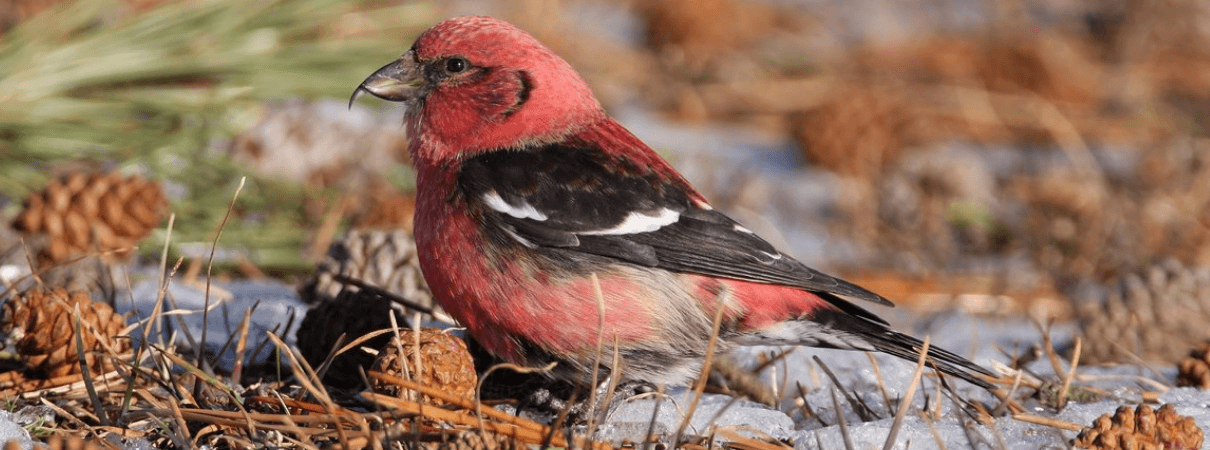
White-winged Crossbill photo by Betty Rizzotti
Though ornithologists have never observed the two species interbreeding in the wild, a captive Red Crossbill and a White-winged Crossbill that were caged together did once produce offspring.
Do Red Birds Face Any Challenges?
Many birds, including the red-colored birds described here, are threatened by a growing number of significant anthropocentric or human-caused threats. In just the last 50 years, North America has lost more than a quarter of its birds.
What's behind this major decline? Researchers are still trying to figure out the causes involved, but we know the following dangers have far-reaching impacts.
Collisions with windows and other human-made structures account for approximately 1 billion bird deaths in the U.S. each year.
Cats kill an estimated 2.4 billion birds every year in the U.S., making cat predation by far the largest source of direct, human-caused mortality to birds.
Every year, millions of acres of critical bird habitat are destroyed throughout the Americas — affecting birds that live permanently in the U.S. and Canada; those that migrate beyond our borders; and also a great diversity of species only found from Mexico and the Caribbean southward. While the net result is hard to quantify, scientists have identified habitat loss as the biggest overall driver of bird declines.
In addition, climate change, poorly sited wind turbines, communication towers, harmful fishing practices, pesticides, and other threats also lead to increased bird mortality.
How Can I Help?
Everyone has a role to play in helping birds rebound.
American Bird Conservancy and our Joint Venture partners have improved conservation management on 6.4 million acres of U.S. bird habitat — an area larger than the state of Maryland — over the last ten years. This is a monumental undertaking, requiring the support of many, and you can help by making a gift today.
Policies enacted by Congress and federal agencies, such as the U.S. Fish and Wildlife Service, have a huge impact on America's birds. You can help shape these rules for the better by telling lawmakers to prioritize birds, bird habitat, and bird-friendly measures. To get started, visit ABC's Action Center.
Finally, don't overlook the impact you can have at home. If you have a garden, for example, you can help hummingbirds by following eight simple steps, which include adding native flowering plants to your garden and reducing pesticide use.
 | Rebecca Heisman is a science writer based in eastern Washington. Her first book, which tells the scientific backstory of how we know what we know about bird migration, will be out in spring 2022. |


















































